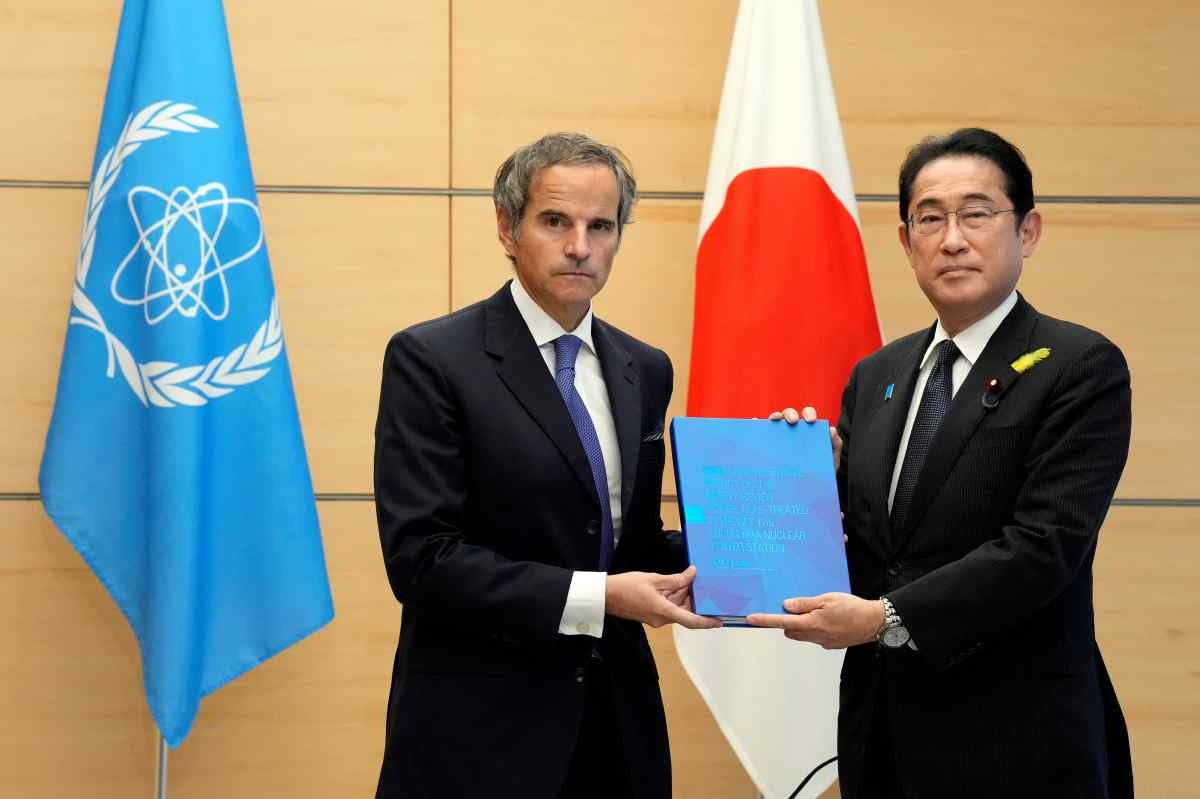IAEA Deems Japan’s Fukushima Water Discharge Plan Consistent with Global Standards

Rafael Mariano Grossi, director general of the International Atomic Energy Agency, presents IAEA’s comprehensive report on Fukushima Treated Water Release to Prime Minister Fumio Kishida at the Prime Minister’s Office in Tokyo on Tuesday.
17:29 JST, July 4, 2023 (updated at 19:00 JST)
Prime Minister Fumio Kishida received an International Atomic Energy Agency report Tuesday that states Japan’s plan to release into the sea treated water from Tokyo Electric Power Company Holdings, Inc.’s Fukushima No.1 nuclear power plant is consistent with international safety standards.
The IAEA director general Rafael Grossi gave the nuclear watchdog’s comprehensive report to Kishida at a meeting in Tokyo.
The government is aiming to start the sea discharge “around summer.” Kishida will decide the timing based on the report.
In the report, the IAEA concluded that the approach to the discharge and the associated activities of TEPCO, regulatory bodies and the government are “consistent with relevant international safety standards.”
Although the IAEA acknowledged that the planned discharge has raised “societal, political and environmental concerns,” it concluded the release “will have a negligible radiological impact on people and the environment.”
After the 2011 nuclear accident in Fukushima, water used to cool the crippled reactors was contaminated with radioactive materials. A treatment process has removed most of the radioactive materials in the water, except tritium.
Under TEPCO’s plan, treated water containing tritium will be diluted with seawater until the concentration is less than one-fortieth of the regulatory standard of 60,000 becquerels per liter. The treated water will then be released into the ocean about a kilometer from the coast via an underground tunnel.
The policy to release treated water into the sea was decided in April 2021, and the IAEA was asked to conduct a safety review of the plan. The watchdog established a task force and sent a team of experts from 11 countries, including China and South Korea to conduct inspections in Japan.
The IAEA will continue the safety review during and after the discharge of the treated water. According to the report released on Tuesday, the agency will maintain an on-site presence at the Fukushima nuclear plant throughout its review and will release real-time and near real-time monitoring data from the plant.
“[T]he work of the IAEA and the Task Force will continue for many years,” the watchdog said in the report.
The IAEA had released six earlier reports in which it described the discharge method and facilities as “appropriate.”
The government hopes to reassure the international community about the safety of the release based on the IAEA’s assessment.
"Politics" POPULAR ARTICLE
-

Japan to Support Central Asian Logistics Route That Bypasses Russia, Plan to Be Part of Upcoming Summit in Tokyo
-

Japan to Tighten Screening of Foreigners’ Residential Status by Providing Information of Nonpayment of Taxes
-

Takaichi Cabinet Approval Holds at 72% as Voters Back Aggressive Fiscal Stimulus, Child Benefits
-

Chinese, Russian Bombers Flew Unusual Path by Heading Toward Tokyo; Move Likely Meant to Intimidate Japan
-

Takaichi Meets Many World Leaders at G20 Debut in Johannesburg; Speaks with Heads of Countries Including Italy, U.K., Germany, India
JN ACCESS RANKING
-

Keidanren Chairman Yoshinobu Tsutsui Visits Kashiwazaki-Kariwa Nuclear Power Plant; Inspects New Emergency Safety System
-

Imports of Rare Earths from China Facing Delays, May Be Caused by Deterioration of Japan-China Relations
-

University of Tokyo Professor Discusses Japanese Economic Security in Interview Ahead of Forum
-

Japan Pulls out of Vietnam Nuclear Project, Complicating Hanoi’s Power Plans
-

Govt Aims to Expand NISA Program Lineup, Abolish Age Restriction
























